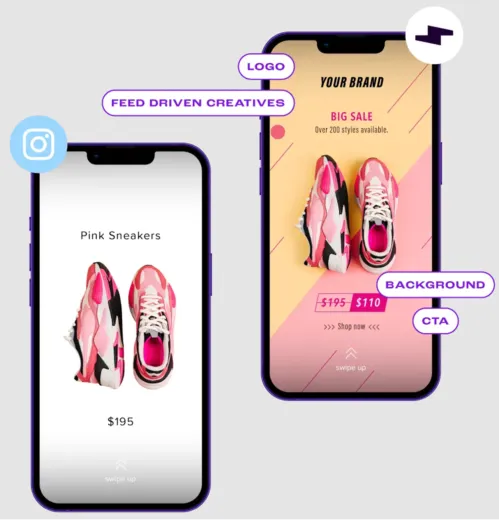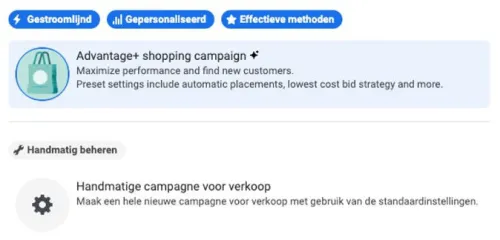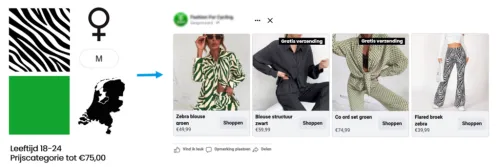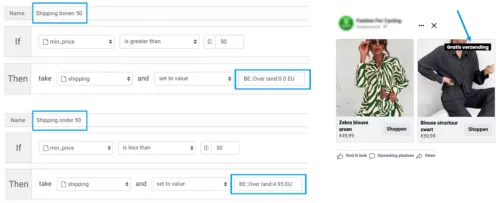Social advertising has played an important role in the online marketing mix of many companies in recent years. With the ever-growing number of social media platforms combined with increasing competition, setting up and managing effective advertising campaigns is becoming more time-consuming and complex. Fortunately, automation offers a solution here!
By using advanced tools and software, we as marketers can work as efficiently as possible by automating and optimizing advertising campaigns. This allows you as a company to get the most out of your marketing budget and also distinguish yourself from the competition.
Reports from Grand View and MarketsandMarkets have shown that the market for social media marketing automation software will grow by a CAGR of 28.3% to €15+ billion in 2025, indicating that this is a rapidly growing trend within the industry.
In this article, we will delve deeper into how your social media marketing strategy can be boosted through automation. We will explore the benefits of automation within social media marketing and cover various topics, such as the best ways to implement automation, the possibilities of automation within social media marketing, and specific tools that can be used for this purpose.
What are the benefits of automation within social media marketing?
Besides the fact that automation within social advertising can be used in various areas, it (naturally) also offers several benefits. Below, we have highlighted the biggest advantages for you:
- Time-saving: The available tools offer automated solutions that can save a lot of time when setting up, managing, analyzing, personalizing, and optimizing advertising campaigns on different social media platforms. This enables us as marketers to work much more effectively.
- Efficiency: Using the available tools helps streamline the process of executing advertising campaigns from A to Z, making it easier to analyze data, optimize, and generate reports.
- Improved performance: A large part of the available tools uses Machine Learning algorithms to optimize and improve ads, allowing us to show highly personalized and optimized ads to your target audience.
- Higher ROI: By using the available tools, the performance of advertising campaigns can be accurately measured, evaluated, and optimized. This can ultimately lead to a higher ROI.
- Better targeting: Tools also offer advanced targeting options that allow the right audience to be reached more accurately based on all the data algorithms have collected over the years.
- More consistency: Automation ensures more consistency in the execution of advertising campaigns, excluding human “errors,” which leads to more consistency.
- Improved customer service: By using tools for automating customer service, it is possible to respond more quickly to questions and comments.
How can you best implement automation within social media marketing?
Social media marketing can be a powerful tool to reach your target audience, increase brand awareness, and generate more purchases or gather more leads. By using automated tools, we as marketers can also ensure that your social media strategy is taken to the next level.
There are many different ways in which automation can be implemented within social media marketing. Below, we have highlighted a few:
- Planning and publishing posts on different social media platforms
- Executing, monitoring, and analyzing advertising campaigns on different social media platforms
- Applying algorithm-based targeting and optimizations
- Personalizing ads based on recent activities, for example
- Dynamic feed integration from other platforms such as a webshop
- Automatically responding to questions and messages for customer service
- Processing and following up on leads from B2B campaigns
Using automated tools within social media marketing can help improve the customer experience with your company. By personalizing ads and, for example, using a dynamic feed integration, you can offer relevant and engaging content to your target audience on autopilot. This can lead to higher engagement and interaction on your social media accounts, which in turn can lead to more sales.
What are the possibilities of automation within social media marketing?
Automation within social media marketing offers us as marketers many possibilities to work more efficiently and effectively with companies' advertising campaigns. As we mentioned earlier, it can help streamline the process of setting up and managing advertising campaigns, gain better insights into the performance of social media activities, and improve interaction with the target audience.
Planning and publishing posts on different social media platforms
Social media management tools like HubSpot or HootSuite can help manage all social media accounts in one place. These tools allow us to schedule, monitor, and analyze posts. By using a social media management tool, we can spend our time more efficiently and ensure consistent and effective communication across all channels.
One of the biggest advantages of a social media management tool is that posts can be scheduled in advance. This allows us to maintain a consistent stream of content across different channels.
Executing, analyzing, and optimizing advertising campaigns on different social media platforms
Executing, analyzing, and optimizing advertising campaigns on different social media platforms can be a challenging task, especially when your company is active on multiple social media channels. Fortunately, there are advanced tools like Hunch and Smartly. These tools use Machine Learning and algorithms to optimize ads and measure and improve performance.

With the help of such tools, it is possible to communicate ads across multiple channels to customers but manage them from a central location. Thanks to smart technology, ads can be automatically optimized. Think of advanced targeting and personalized visuals. Additionally, these tools offer extensive reporting capabilities to analyze account performance.
Applying algorithm-based targeting and optimizations
In addition to external tools that can be linked to various social media channels, there are also more and more new functionalities within platforms that are automated. For example, within Meta, “Advantage+” has been introduced.
Advantage+ is a new tool within Meta that allows us to automatically target ads in a more personalized way, while most of the thinking is done by Meta's algorithm.

The main advantage of Advantage+ is that ads can be better tailored to the target audience by reaching them at the right time and place. This can lead to better ad performance and higher conversion rates.
According to Meta, ads that use automated Advantage+ targeting options are 25% more effective than ads that do not use these tools. Meta claims this is because the AI algorithms are better able to identify and target the right audience.
Advantage+ uses Machine Learning and artificial intelligence to identify the best audiences for each ad. This means that we as marketers spend less time manually identifying audiences and more time creating relevant and engaging ads.
Personalizing ads based on recent activities, for example
Personalization is an increasingly recurring topic within social media marketing. Nowadays, it is also possible to advertise in a personalized way automatically with tools. In addition to tools for easy multi-platform advertising, Hunch and Smartly are used to automatically design personalized creatives and dynamically show them to the right audience.

Additionally, there are other tools like Adflow that make it possible to create different types of personalized ads, including dynamic ads that are automatically adjusted based on the user. For example, if a user recently viewed a product on a website, Adflow can create an ad promoting that specific product and then display this ad on various social media platforms.
Finally, it is also possible to not only respond to the activities of website visitors but also use external factors such as the weather. “Weather Based ads” are another way to personalize ads and respond to the needs and interests of users. At Meta, for example, this can be done by advertising products or services that are relevant to the current weather in the target audience's region.
Research has shown that Weather Based ads, where the content of the ad is adjusted to the weather at that moment, have a higher Click-Through Rate (CTR) than regular ads. A case study by the online travel agency Expedia shows that their Weather Based ad had an average 3x higher CTR than their regular ads.


Dynamic feed integration from other platforms such as a webshop
Feed-based advertising is a way to advertise your products on various social media channels. The idea is to create targeted ads for each individual visitor to your website through an optimized product feed. This product feed contains information about your products, such as titles, descriptions, images, prices, and availability. By automatically forwarding this information to social media platforms, we as marketers can ensure that your target audience is targeted with the products they have just viewed or products that the algorithm thinks are a good match for that person.

One of the biggest advantages of feed-based advertising is that you can create highly targeted ads based on the information in the product feed. This allows us to tailor the ads to the needs and interests of your target audience. Another advantage is that it is less time-consuming than manually adding and updating each product in your webshop and creating individual ads for them. In summary, ads can be automatically created for all products in your webshop with an optimized product feed.
An example of a tool that can link your product feed and be used for dynamic feed-based advertising campaigns is Channable. With Channable, we can optimize the information in your product feed and link it to social media channels, so the link can be better established from the platforms. Additionally, Channable also offers the possibility to use your product feed for dynamic retargeting. This allows us to automatically create ads for products that potential customers have previously shown interest in.
According to Channable, users of an automated dynamic feed integration see an average increase in revenue of 30% and a 50% time savings on managing their data feeds.

Automatically responding to questions and messages for customer service
Another form of automation within social media marketing is tools that can help monitor responses to messages and automatically respond to frequently asked questions or comments. This helps improve your customer service and respond more quickly to customer requests.
Tools like Intercom and Tidio are automated systems designed to understand customer messages and generate automatic responses. They can be programmed to answer customer questions and provide useful information. These so-called chatbots can be integrated with social media channels and your website.
Tip: As a company, you can also set up automatic responses on your social media accounts. These responses can provide customers with basic information about your company, such as opening hours or contact details, and refer them to the website or other relevant information.
Using tools like Intercom and Tidio has several advantages, including reducing customer wait times, improving customer service efficiency, and increasing customer satisfaction. However, it is important to ensure that the automatic responses are useful to customers and that there is always the option for customers to directly contact a customer service representative for more complex questions or issues.
Processing and following up on leads from B2B campaigns
As marketers, we want to know what an advertising campaign actually delivers, but this is often very difficult to determine when leads are provided from B2B campaigns on social media channels. By integrating social media channels with tools like HubSpot and HootSuite, it is possible to measure the impact of advertising campaigns and further optimize the marketing strategy.
The biggest advantage of such an automated integration is that it is possible to achieve measurable results. Through advanced audience segmentation within workflows, leads can be fully processed and (as far as possible) followed up.
According to HubSpot, companies that use their marketing automation tool see a 60% increase in the number of leads, a 14% decrease in cost per lead, and an average 49% increase in revenue.
Tools like HubSpot and HootSuite offer a range of marketing tools and features that we as marketers can use to automate your advertising campaigns as much as possible. These platforms offer features for lead tracking and lead scoring, which automatically identify and segment potential customers. This allows us to improve the efficiency of the sales funnel and make results more insightful (on autopilot).
Conclusion
In summary, we see automation within social media marketing only growing in the coming years. We expect more and more tools to become available and that the currently available tools will become more extensive. Automation is therefore going to play an increasingly important role in your company's social media marketing mix.
Currently, automation can already be implemented in various ways within social media marketing for your company. Examples include planning and publishing posts on different platforms, executing and analyzing advertising campaigns on different channels, applying algorithm-based targeting and optimization, automatically responding to questions and messages for customer service, and following up on leads from B2B campaigns.
In short, using advanced tools for automation within social media marketing offers us as marketers the opportunity to give your social media advertising campaigns a boost!




